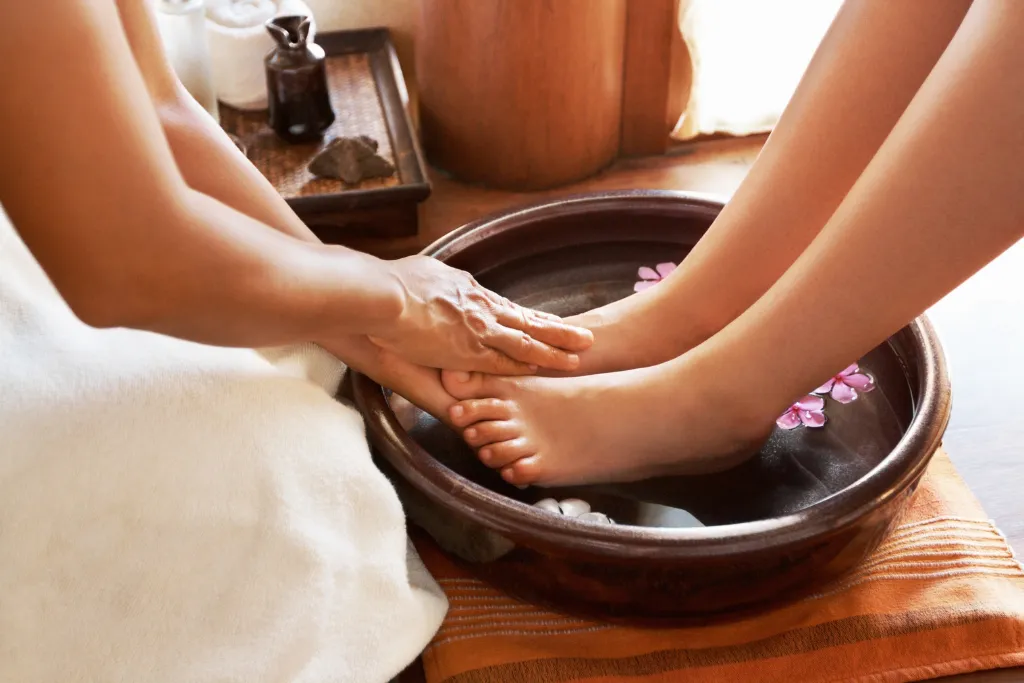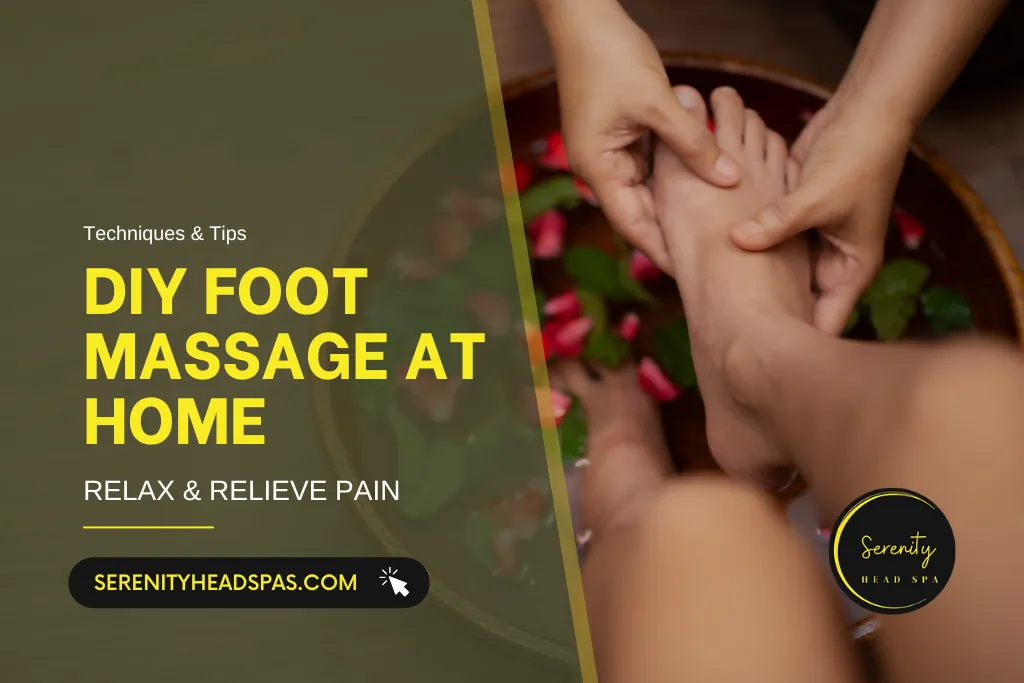Foot massages are an excellent way to unwind and release stress after standing, walking, or exercising all day. They help you feel relaxed and alleviate foot pain, promote circulation, and ease aches from the heel and arch of your foot and ankles.
Below, we share how to massage your feet at home, focusing on two places that can really hold tightness, soreness, and stress.
Whether you’re dealing with plantar fasciitis or foot pain of any kind, or are simply looking to pamper your feet, picking up a few tips on basic foot massage techniques will allow you to soothe your feet and improve their overall health. Here’s a few ways to a simple self-massage in your own home!
Benefits of a Foot Massage
So before getting into the techniques, let’s explore some of the benefits of foot massage:
- Eases Stress: A foot massage can release tension in your feet, toes, and ankles with gentle massage therapy on pressure points.
- Boosts Circulation: Massaging your feet encourages blood flow beneath the arch of your foot, heel, and toes, helping to reduce swelling and improving general circulation.
- Relieves pain: If you suffer from chronic issues like plantar fasciitis or heel pain, a foot massage can relieve pain.
- Relieves Stress: A massage can help you relax after a long, tough day.
Foot Massage at Home: Techniques to Try
Foot massages are not complex to give yourself. Using some simple moves, you can focus on your feet’s arch, heel, and toes to release tension and encourage relaxation.
Step 1: Make Your Feet and Space Ready
First, find a comfy chair or foot spa you can sit in to relax. You’ll want access to your feet. You could even put your feet in warm water for a few minutes to soften the skin and make the massage more effective. As a final touch, sprinkle in some bath salts or essential oils for added benefit.
Then, remember to have lotion or oil nearby, so you have a smoother time massaging. A good massage oil will avoid any friction and will help your hands glide over the top of your foot.
Step 2: Begin With Gentle Warm Up
Begin to warm your feet up by rubbing them warmly to promote blood circulation. This is a great way to start self massage, especially after having been on your feet all day.
- Using both hands, rub the bottom of the foot with light pressure, massaging it. Begin with the ball of your foot and towards the heel.
- Start relieving any tension or discomfort by applying gentle pressure to acupuncture points, such as the arch of the foot and heel, with your thumb.
Step 3: Target Specific Areas
Clean all the different foot areas and foot body parts. Once your feet are warmed up, target specific areas that may need extra attention:
The Arch of the Foot
- This area is a common area of tension/tightness. Here’s how to relieve it:
- Slide your thumb and apply gentle pressure along the arch.
- Use kneading motions to work out any tension in this space.
- You can also apply some pressure gently on the arch with a ball of your foot.
The Toes and Balls of Your Feet
Your toes and the balls of your feet take a lot of pressure throughout the day. To relieve tension here:
- Pull each toe out straight, one at a time.
- Rub your thumb around the ball of your foot in a circular motion, moving from the center of the foot to the toe side and heel side.
The Heel
The heel tends to get tight because many people have conditions such as plantar fasciitis. Here’s how to target it:
- Press gently on the heel with your thumb or the ball of your foot.
- While keeping your heel down, stroke slowly and firmly from the heel to your toes to dissipate heel pain.
The Ankle and Achilles Tendon
Areas where stiffness can interfere with performance Laura continues: “The ankle and Achilles tendon are common areas that can stiffen after exercise:
- Gently apply pressure with your thumb to your Achilles tendon and glide upward toward your calf.
- This can also ease the strain on the ankle and relieve some swelling and pain.
Step 4: Add in Reflexology Techniques
Reflexology involves massaging certain pressure points in the foot that are believed to correlate with other parts of your body. If you want to incorporate reflexology into your foot massage, here’s how:
- Big Toe: This is believed to correspond with the head and neck area. Use light pressure for relaxation on the big toe and base of the toe.
- Middle of Your Foot: The middle of your foot corresponds to the stomach and digestive system. If constipation is a problem, applying pressure here may help digestion.
- Production: The production relates to the lower back. Using some gentle pressure here can be helpful for relieving back pain or tension.
Step 5: Close with a Soothing Massage
Complete the foot massage by relaxing your foot and calf muscles:
- Use gentle strokes along the soles of your feet, from heel to toe.
- Pull your toes one last time gently and knead the ball of your foot again.

Additional Foot Massage Tips
Although getting a foot massage can be a wonderful way to cause tension in the feet to melt away, there are many other foot care practices you should implement in order to ensure your feet stay healthy. Consider these tips:
Use a Foot Massager
If you are looking for a hands-free experience, try using an electric foot massager or shiatsu foot massager. They have soothing vibrations and pressure that relieve foot pain, and offer a similar potential to a professional one.
Use Cold or Warm Compresses
If you feel acute pain or stiffness, you can either apply cold or warm compresses to your foot. That helps with inflammation and gives comfort.”
How Often to Massage Your Feet
If you have sore feet or plantar fasciitis; or even if just your feet feel tired after a long day; get in the habit of rubbing your own feet. Doing so may facilitate circulation and stave off discomfort.
Foot Massage for Specific Conditions
A foot massage can be particularly beneficial for anyone dealing with plantar fasciitis or heel pain. If you’re managing foot pain or sore feet, see if you can apply more targeted pressure on the ball of the foot and arch to relieve discomfort.
Give your tired feet a refreshing and rejuvenating spa in the comfort of your home by soaking your legs and feet, as well as a light foot massage that helps in relaxing your muscles. For the long term you can create a massage technique on your own to reduce swelling and improve circulation in your feet.
If you’re in recovery mode from foot surgery or suffering foot pain, it’s crucial to see your healthcare provider or podiatrist before performing foot massage techniques, as this may be counterproductive if you’re healing.
When to Seek Professional Help
Although self-foot-massaging at home is super helpful, there are times when you need the assistance of a podiatrist or regular massage therapist.
If you have nagging foot pain, swelling or other foot problems such as plantar fasciitis that aren’t alleviated with self-care, you should see a pro. And other medical conditions such as foot surgery need more specialized treatments and professional care.
Conclusion
One of the easiest methods to relieve tension and relax sore feet is to give yourself an incredibly simple foot massage. Targeted massage at areas like the arch, heel, and toes can relieve foot pain, increase circulation, and provide a relaxing experience after a long day.
So if you struggle with more chronic conditions, like plantar fasciitis or heel pain, a foot massage may help relieve the discomfort, but do talk to a podiatrist or massage therapist qualified to specialize when there’s a need.
Armed with the right techniques, you can reap the many benefits of foot massage at home, keeping your feet healthy and pain-free.

